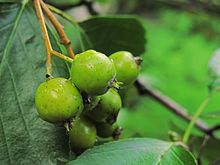Franconian whitebeam
| Franconian whitebeam | ||||||||||||
|---|---|---|---|---|---|---|---|---|---|---|---|---|

Franconian whitebeam ( Sorbus franconica ) |
||||||||||||
| Systematics | ||||||||||||
|
||||||||||||
| Scientific name | ||||||||||||
| Sorbus franconica | ||||||||||||
| Bornm. ex Düll |
The Sorbus Franconica ( Sorbus franconica ), also known as Frankish bastard Mehlbeere referred to, is a plant type , which for the complex of the bastard flour berries ( Sorbus latifolia belongs agg.). It is a deciduous tree that is believed to have originated from a hybridization of the hill whitebeam ( Sorbus collina ) from the Sorbus aria group with the service tree ( Sorbus torminalis ). It is an apomictic species and reproduces asexually.
Alexander Sennikov and Arto Kurtto have been running the species since 2017 under the name Karpatiosorbus franconica .
description
The Franconian whitebeam is a deciduous or deciduous tree or shrub that reaches heights of 10 (rarely up to 15) meters and often appears as a multi-stemmed rash. The leaves look very similar to those of the Baden whitebeam ( Sorbus badensis ). They have a 10 to 15 millimeter long petiole. The leaf blade becomes 7.5 cm long and 4.5 cm wide. It has a obtuse-wedge-shaped base and tapers towards the top. The leaves have four, sometimes five pairs of pointed lobes and usually nine (less often eight or ten) pairs of lateral nerves. Leaves of sterile short shoots often have a pair of lobes more and a pair of lateral nerves less than the fertile short shoots. The depth of the flap incisions is 5 to 7 millimeters there. The diameter of the leaf hairs varies between 9 and 11 micrometers.
The egg-shaped orange-yellow fruits look like a small apple. They reach a length of 10 to 12 millimeters and a width between 10 and 11 millimeters. The epidermis of the fruit shows lenticels with a diameter of 0.2 millimeters. The triangular calyx leaves are fleshy, do not dry up after flowering and remain splayed until ripe.
The pollen is up to 60 percent deaf and the germination rate is said to be good.
Occurrence
distribution
This species is endemic to the north of the Free State of Bavaria . It grows there in the Wiesent - Jura in Franconian Switzerland . The Franconian whitebeam has become quite rare, but is not particularly protected by the Federal Species Protection Ordinance. According to the Red List , it is considered endangered in the Free State of Bavaria.
Location
The Franconian whitebeam prefers light, beech-rich mixed forests. It always grows on white jurassic lime soils, especially on dolomite. They can be found in Franconian Switzerland at altitudes between 450 and 500 meters. The Franconian whitebeam usually grows in company with the two parent species. Sometimes a parent steps down, and both types of parents can be absent. It tolerates more shade than Sorbus aria and colonizes higher altitudes than Sorbus torminalis .
Botanical history
Kaufmann (1892) and August Friedrich Schwarz (1915) indicated today's species in local flora as a bastard for several sites. The name Sorbus franconica goes back to Joseph Friedrich Nicolaus Bornmüller (1918) . He saw the clan as a bastard of Sorbus graeca and Sorbus torminalis . Zoltan Kárpáti divided the Sorbus latifolia group in 1960 into a coarse and small-leaved Sorbus franconica group ( Sorbus graeca × Sorbus torminalis ) and a soft and large-leaved Sorbus latifolia group ( Sorbus aria × Sorbus torminalis ). Based on the results of flavonoid studies , this classification is predominantly hypothetical. Ruprecht Düll (1961) gave the clan species rank as an apomictic taxon. Konrad Gauckler expanded the previously known sites and noted the newly found sites on the manuscript maps created by Schwarz.
In the 1970s to 1990s, the Franconian whitebeam was also assigned to occurrences in the southern Franconian Alb, which, however, in the revision by Meyer u. a. (2005) were separated as separate small species. In the Regensburg area, the Franconian whitebeam is being replaced by three taxa ( Sorbus ratisbonensis , Sorbus mergenthaleriana and Sorbus hoppeana ), in the Altmühltal by Sorbus eystettensis , in the Ries by Sorbus fischeri .
literature
- Herfried Kutzelnigg: Sorbus. In: Hildemar Scholz (Hrsg.): Illustrated flora of Central Europe . Founded by Gustav Hegi. 2nd completely revised and expanded edition. Volume IV Part 2B: Spermatophyta: Angiospermae: Dicotyledones 2 (3) (Rosaceae, 2nd part) . Blackwell, Berlin / Vienna a. a. 1995, ISBN 3-8263-2533-8 , pp. 328-385; S. franconica : pp. 372-373 .
- Alexander Sennikov, Arto Kurtto: A phylogenetic checklist of Sorbus s. l. (Rosaceae) in Europe. In: Memoranda Soc. Fauna Flora Fennica 93, Helsinki 2017, pages 1-78. https://journal.fi/msff/article/view/64741
- Martin Lepší, Petr Lepší, Petr Koutecký, Jana Bílá & Petr Vít, 2015: Taxonomic revision of Sorbus subgenus Aria occurring in the Czech Republic; Preslia 87: 109-162.
Individual evidence
- ↑ Alexander Sennikov, Arto Kurtto: A phylogenetic checklist of Sorbus s. l. (Rosaceae) in Europe. In: Memoranda Soc. Fauna Flora Fennica 93, Helsinki 2017, pages 1-78. https://journal.fi/msff/article/view/64741
- ^ A b c Norbert Meyer, Lenz Meierott, Herbert Schuwerk, Otto Angerer: Contributions to the genus Sorbus in Bavaria. In: Reports of the Bavarian Botanical Society for the Research of Native Flora , special volume, 2005: pp. 5–216 ( Sorbus franconica : pp. 135–139).
- ↑ Martin Scheuerer, Wolfgang Ahlmer: Red List of Endangered Vascular Plants in Bavaria with a regionalized list of flora. In: Series of publications. Bavarian State Office for Environmental Protection. Volume 165, 2003, ISBN 3-936385-58-0 .
Web links
- BiolFlor research system - Sorbus franconica
- Franconian whitebeam. In: FloraWeb.de.
- Profile and distribution map for Bavaria . In: Botanical Information Hub of Bavaria .
- Thomas Meyer: Data sheet with identification key and photos at Flora-de: Flora von Deutschland (old name of the website: Flowers in Swabia )
- IUCN factsheet - Sorbus franconica (English)

